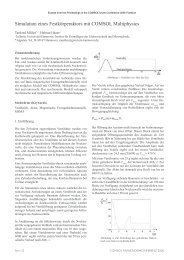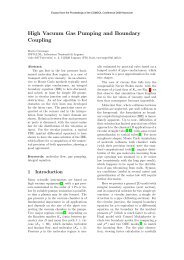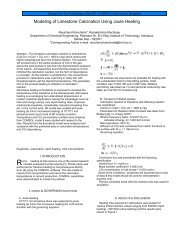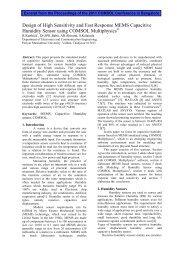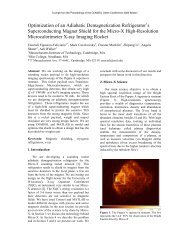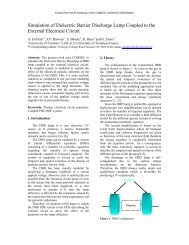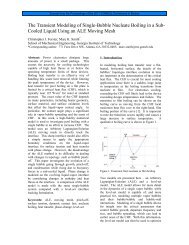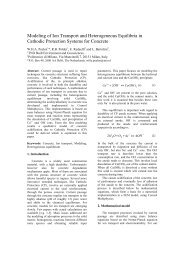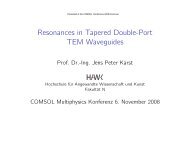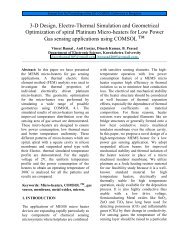Improved finite element modeling of heat and mass ... - COMSOL.com
Improved finite element modeling of heat and mass ... - COMSOL.com
Improved finite element modeling of heat and mass ... - COMSOL.com
You also want an ePaper? Increase the reach of your titles
YUMPU automatically turns print PDFs into web optimized ePapers that Google loves.
Exact physical measurements are needed as<br />
input parameters for the models. Knowing the<br />
driving potentials (forces) during <strong>heat</strong> <strong>and</strong> <strong>mass</strong><br />
transfers are necessary for an accurate model.<br />
Water potential gradients as the driving force are<br />
used in contrast with the practice (where<br />
moisture gradients were used) for <strong>modeling</strong> <strong>of</strong><br />
<strong>mass</strong> transfer in maize hybrids. For this the water<br />
potential curves <strong>of</strong> the materials are have to be<br />
determined. Desorption isotherms were<br />
measured on 40 <strong>and</strong> 50 °C <strong>of</strong> maize hybrids <strong>and</strong><br />
their constituents (pericarp, scutellum,<br />
endosperm.).<br />
Water potential curves can be either directly<br />
calculated from the sorption equations. On the<br />
other h<strong>and</strong> sorption isotherm measurements <strong>of</strong><br />
agricultural materials have been carried out for<br />
decades [3]. Several papers were published for<br />
w<strong>heat</strong> <strong>and</strong> maize grains’ isotherms [4, 5, 6, 7].<br />
Most <strong>of</strong> the cases different salt solutions were<br />
used to set the relative humidity <strong>of</strong> the measuring<br />
chamber <strong>and</strong> the kernels were set until<br />
equilibrium weight. The method is time<br />
consuming <strong>and</strong> the kernels can deteriorate<br />
especially over 80% RH [4]. The literature data<br />
<strong>of</strong> the sorption isotherms <strong>of</strong> maize constituents<br />
are in controversy [1, 2]. First <strong>of</strong> all data <strong>of</strong> the<br />
high moisture content region is differ. Other<br />
difficulties are the great number <strong>of</strong> empirical<br />
equation that present in literature [8, 9]. A<br />
general equation has not been developed so far.<br />
Special measurement technique is required to<br />
determine the higher sections <strong>of</strong> the water<br />
sorption isotherms. Direct measurements for<br />
water potential were initiated using a „pressure<br />
plate extractor” (PPS) developed at the<br />
University <strong>of</strong> Saskatchewan, Canada for<br />
measuring soil samples [10]. The PPS consist <strong>of</strong><br />
a calibrated ceramic plate <strong>and</strong> a pressurized<br />
chamber. This method was adapted from soil<br />
science where measurements <strong>of</strong> pF values (soil<br />
water potential) are well known. In this way a<br />
water content <strong>of</strong> the sample is determined in<br />
such way that the <strong>mass</strong> <strong>of</strong> the sample <strong>and</strong> the<br />
equipment are measured together.<br />
2. Governing Equations<br />
The basic governing differential equation<br />
system for the drying processes was given by<br />
Luikov [11]. It was simplified by Husain et al.<br />
[12] in the following form:<br />
�X<br />
� �(<br />
D�X<br />
)<br />
��<br />
(1)<br />
�T �X<br />
� � �k�T<br />
� L�<br />
(2)<br />
��<br />
��<br />
where: X is the moisture content d.b. [kg/kg]; D<br />
is the diffusion coefficient [m 2 /s]; � is the<br />
density [kg/m 3 ]; c is specific <strong>heat</strong> [J/kgK]; T is<br />
the temperature [K]; � is the time [s]; k is the<br />
thermal conductivity [W/mK]; L is the latent<br />
<strong>heat</strong> <strong>of</strong> vaporization <strong>of</strong> water [J/kg].<br />
The previously mentioned simplifications<br />
were realized by other scientist <strong>and</strong> they try to<br />
consider the problem by e.g. taking account the<br />
different physical properties <strong>of</strong> the different<br />
constituents [13, 14]. Other way was to give the<br />
coefficients as functions instead <strong>of</strong> constants<br />
[15].<br />
The above equation systems proved that<br />
inside moisture distribution in e.g. a single maize<br />
kernel <strong>and</strong> the calculated distribution does not<br />
agree [16]. The authors try to enhance the model<br />
accuracy by taking account the non-permeability<br />
<strong>of</strong> the epithelium layer between the scutellum<br />
<strong>and</strong> germ [17]. The biggest problem with the s<strong>of</strong>ar<br />
used <strong>modeling</strong> is that the model intents to<br />
equalize the moisture concentration that is not<br />
correct since the moisture content <strong>of</strong> the<br />
constituents are different in equilibrium state<br />
(Fig. 1.).<br />
Moisture content <strong>of</strong> the constituents,<br />
X [kg/kg]<br />
0.6<br />
0.5<br />
0.4<br />
0.3<br />
0.2<br />
0.1<br />
endosperm<br />
scutellum<br />
0.0<br />
0.05 0.10 0.15 0.20 0.25 0.30 0.35<br />
Moisture content <strong>of</strong> the whole kernel, X [kg/kg]<br />
Figure 1. Moisture content <strong>of</strong> the particles vs.<br />
whole maize kernels.<br />
Based on the above mentioned facts it is<br />
clear that the using moisture gradient as the<br />
driving force is not correct. Luikov [11] took the<br />
water potential (<strong>mass</strong> transfer potential) the same<br />
way as the <strong>heat</strong> transfer potential (temperature).<br />
He proposed cellulose as the st<strong>and</strong>ard body. The<br />
authors give the following equation for <strong>mass</strong><br />
transfer potential based on the chemical potential<br />
<strong>of</strong> ideal gases <strong>and</strong> considering that the material is<br />
a capillary-porous body:



